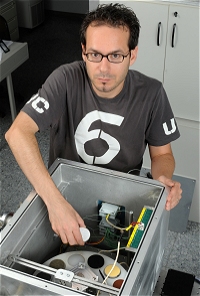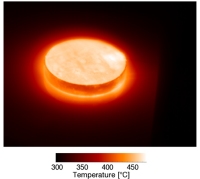Recreating Venus in the lab
30 July 2010
Scientists are able to learn about the atmospheres and surfaces of planets by studying their spectra - the different wavelengths of light which they reflect or absorb. However, when researchers study spectra of Venus, the hottest planet in the Solar System, they run into a problem. Its high temperatures and pressures seriously affect the data.Venus and Earth are often described as sister worlds. However, the second planet from the Sun has obviously evolved in a very different manner from our Earth. The surface of Venus is very hot, with temperatures reaching 480 degrees Celsius, and its surface pressure is 90 times greater than on Earth. These extreme conditions cause great difficulties for scientists who are attempting to unveil the mysteries of the Venusian lower atmosphere and surface.
"Remote observation of the surface and atmosphere, particularly at infrared wavelengths, enables us to probe the deepest regions of the atmosphere and surface of Venus," explained Håkan Svedhem, Venus Express Project Scientist.
"On Earth, we understand the spectral absorption lines in the atmosphere, so we can calculate their effects. However, the high temperatures and pressures on Venus make observations much more complex. We don't know precisely how they modify the spectra, so it is impossible to interpret the data accurately."
 |
|
Preparing mineral samples at the Planetary Emissivity Laboratory. |
In the Planetary Emissivity Laboratory in Berlin, Joern Helbert and colleagues are trying to find out by heating rock and dust samples to 500 °C. As their temperatures rise, the samples start to glow, first in the infrared and then in the visible. Since the relative strength of this glow at different wavelengths - its emissivity - is unique to each material, it can be used to identify rocks on the planet's surface.
"High temperatures change the internal structure of minerals, so that some become brighter and others are darker," said Dr. Helbert.
"We have been working on this problem for three years, using a unique apparatus in which we heat samples in stainless steel cups with an induction heating system. This enables us to go very quickly to high temperatures and keep the temperature very stable. We are now starting to make real measurements of basalt, haematite and granite in the lab, so that we can compare them with emissivity data from VIRTIS."
 |
|
Thermal infrared image of mineral sample in Venus-like conditions. |
Understanding the properties of the carbon-dioxide-enriched atmosphere presents another major challenge. The lower atmosphere of Venus is like an extreme pressure cooker which is twice as hot as a domestic oven. All light from the surface must pass through this dense, overheated atmosphere before reaching the instruments on Venus Express.
The carbon dioxide blocks most infrared light coming from the surface, but the optical properties of the gas are not fully understood, especially at wavelengths where the gas is almost "transparent". Scientists want to understand how the atmosphere absorbs light from below, and to define accurately the spectral windows which give the clearest views of the lower atmosphere and surface. Only then will they be able to comprehend the finest details of the spectrum and unravel the nature of the planet hidden beneath its blanket of cloud and thick greenhouse gas.
To fill this gap in knowledge, a team led by Giuseppe Piccioni, Principal Investigator for the VIRTIS instrument, is trying to reproduce Venus' atmospheric conditions in the lab. Their research at IASF-Rome of the National Institute for Astrophysics, Italy, involves studying carbon dioxide spectra at temperatures and pressures similar to those on Venus.
|
Laboratory spectroscopy of gases in Venus-like conditions. |
Gas cell containing carbon dioxide under Venus-like conditions. |
"We use tiny sample cells filled with carbon dioxide, which have to be carefully constructed to withstand the extreme conditions," said Piccioni. "We then use very high resolution spectrometers in order to get precise measurements of the light absorption by the gas."
The painstaking lab work is ongoing, but once the relatively clear spectral windows are clearly defined and recognised, it will be possible to produce accurate, three-dimensional models of the distribution of atmospheric temperatures and gases in the lower atmosphere.
This breakthrough will open the door to detailed analysis of the dynamics and composition of the atmosphere, including the mysterious four-day wind circulation, the polar vortices, and the distribution of water and other minor constituents.
Papers on both of these research activities were presented at the COSPAR conference in Bremen, Germany, 18-25 July 2010.
Contact
Håkan Svedhem, Venus Express Project Scientist
Phone: +31 71 565 3380
Email: hsvedhem rssd.esa.int
rssd.esa.int
Giuseppe Piccioni, VIRTIS PI
Phone: +39 06 45488 445
Email: giuseppe.piccioni iasf-roma.inaf.it
iasf-roma.inaf.it
Stefania Stefani
Phone: +39 06 45488 547
Email: Stefania.Stefani iasf-roma.inaf.it
iasf-roma.inaf.it
Joern Helbert
Phone: +49 30 67055 319
Email: Joern.Helbert dlr.de
dlr.de
Alessandro Maturilli
Phone: +49 30 67055 313
Email: Alessandro.Maturilli dlr.de
dlr.de

